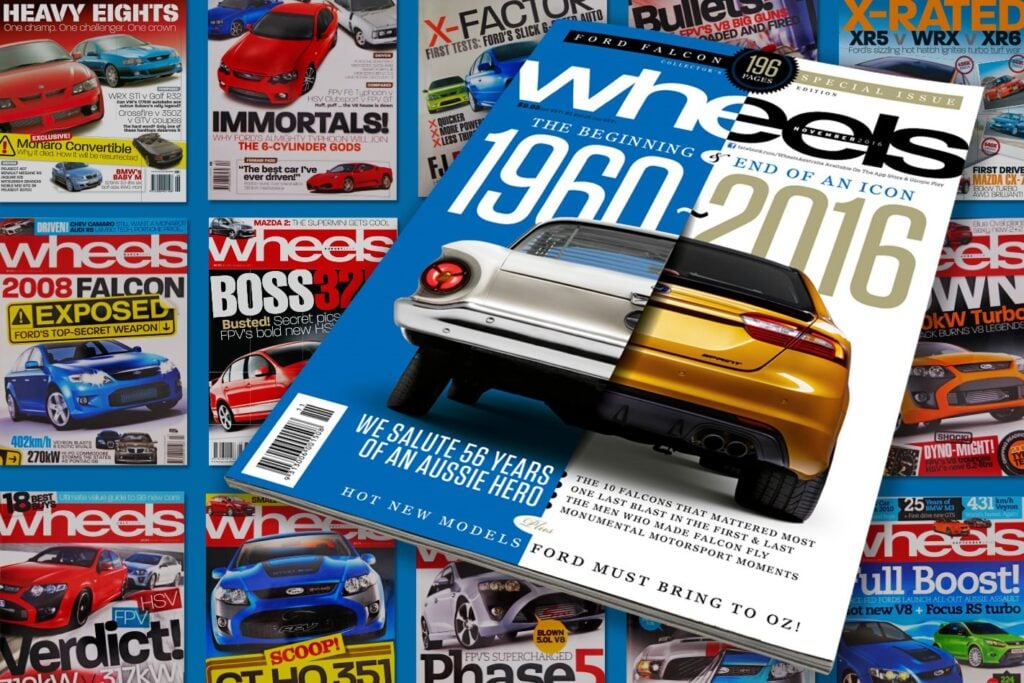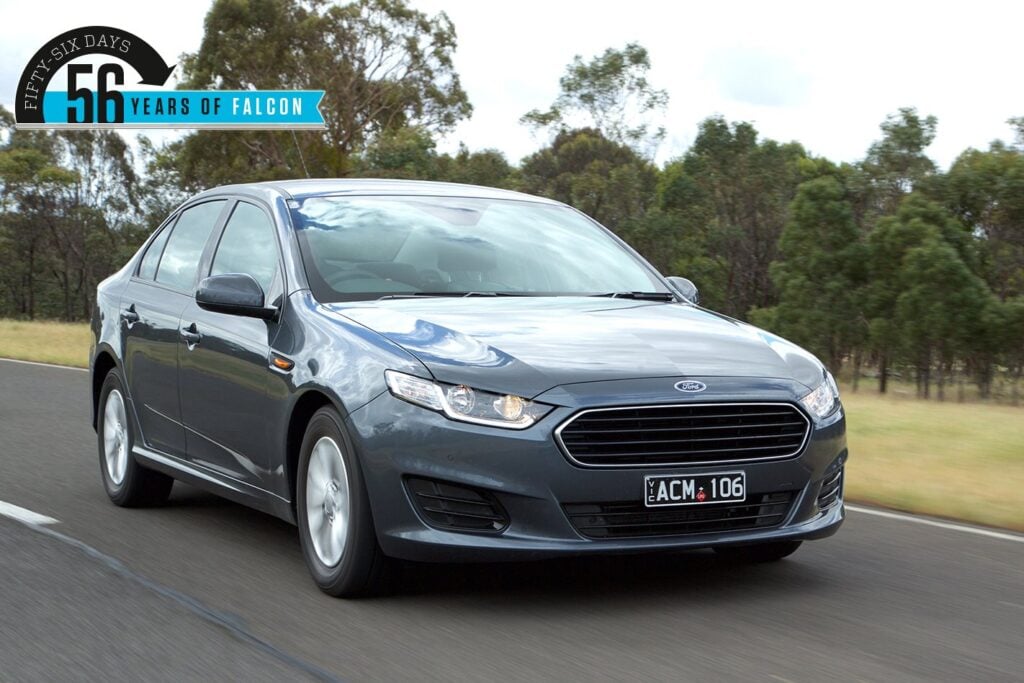First published in the October 1988 issue of Wheels magazine, Australia’s best car mag since 1953.
Wheels took the two rivals and pounded them over a four-car total of 21,000km in our toughest-ever comparison. Trail boss Mike McCarthy gives the verdict.
BREAK THE bastards! That’s what the man said when he learned Wheels was testing the Holden VN Commodore and Ford EA Falcon. Like other blokes all along the way, blokes who told us to drive them into the ground or give ’em bloody heaps, our Toowoomba carwash critic wasn’t kidding. Nor were we.
It’s a classic confrontation – Ford versus Holden. But never has the battle between the General and Henry had so much at stake. Never have the cars and the companies been so closely matched. This is where they tough it out for the Number One spot with Ford in defence, Holden on attack.
Knowing this was the first round of the giants’ big punch-up, people everywhere wanted the Falcon and Commodore driven to the limits of endurance; to be tested hard and fast, good and proper, to find the strengths and weaknesses.
That’s what Wheels was there for. This became our biggest, longest, toughest four-car comparison ever, with a crew of six testing two sedans and two wagons over more than 21,000 km. We were 10 days in the saddle, including the first day ferrying the Fords from Sydney to Southport, and the last day running performance tests at a private road outside Sydney.
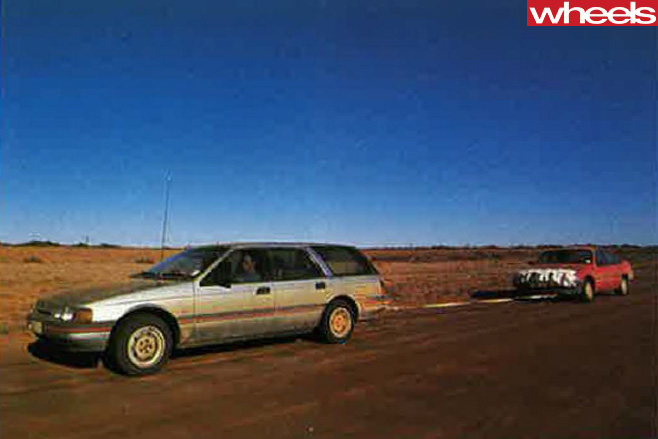
There have been many other epic Wheels drives, but never a four-car comparo on this scale. It was, however, the only way to find answers to the questions posed by the release of a brand new Falcon and brand new Commodore in the space of six months. If nothing else, we needed to know whether, after some early hiccups and the benefit of nine months in production, Ford had got the Falcon right.
And whether, after 10 years of playing second fiddle not only to the Falcon but also to the indelible memory of the immortal Kingswood, the new VN was good enough, tough enough and really big enough to put Holden back in the winner’s circle.
It was obvious from the outset that the answers wouldn’t come easy because the models have grown very close in their basic designs, their size and their curvy aero styling.
Indeed, many interested onlookers had trouble telling them apart, especially when the four were covered by a drab coat of reddish mud best described as Birdsville Brown.
Several people called them Button-mobiles and mused, only half joking, as to whether some panels might be interchangeable. The design similarities don’t go anywhere near that far, but even so, both camps share some mechanical aspects such as live rear axles with coil springs (except on the leaf springed Falcon wagon), variable ratio power steering and four-wheel disc brakes. Apart from disagreeing about front suspensions (the Commodore continues with struts and the Falcon with wishbones), the biggest single differences are under the bonnet.
Both engines are sixes, but Ford stuck with an in-line design (with three variations on the theme) where Holden opted for a V6 version (to be supplemented by a VS next year). Then there are the transmissions. Both makers use similar Borg-Warner T5 five-speed manuals but disagree on automatics.
PRICES, EQUIPMENT
Everyone assumed Holden would bump prices up a bit for the new VN. Instead, the old figures stood. And the industry went into mild shock. A Holden dealer told us his first reaction (thinking of how to unload remaining old-model stocks) was “bloody near a heart attack”. Holden’s pegged prices meant cardiac concerns at Ford, too. But where Commodore dealers’ fears were unfounded because the old VL was almost sold out before the VN arrived, the price problem won’t go away that easily for Ford.
Dollar-wise, the Falcon and Commodore models are locked together. In basic sedans, for instance, the five-speed Falcon GL and Commodore Executive list at precisely $20,014. Pricing can’t be more competitive than that, right? Wrong. The base Falcon, y’see, comes with a small 3.2 litre/90 kW engine that’s not within coo-ee of the 3.8 litre/125 kW port-injected Commodore. To compete directly with that, the Falcon needs the 3.9 litre/139 kW multi-point injection model which adds $984 to the base figure. For those torn between price and performance, Falcon’s other-choice compromise is the 3.9 litre/120 kW throttle-body engine which costs only $319 extra and takes the list figure to $20,333.
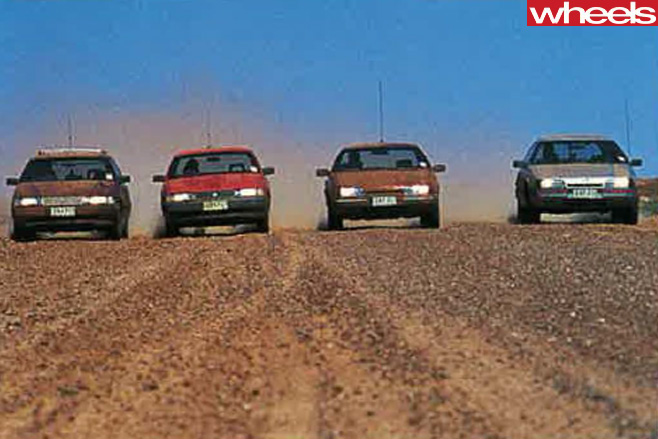
As with the base models, there’s seeming price parity at other levels, too. The Berlina auto sedan, for instance, lists at $24,781 which is line-ball with the throttle-body 3.9 auto Fairmont, or $579 less than Ford’s multi-point model.
Direct price/performance equivalence is reached only at the $31,265 level where the Calais faces Fairmont Ghia.
PERFORMANCE
This is one of the areas where Commodore’s challenge is strongest, and where its superiority is most visible. As the manual wagons’ acceleration figures show, the result is fairly close when Ford’s big gun is under the bonnet. But when the Falcon is an automatic with the 3.9 throttle-body engine, the results are as predictable as they’re far apart.
Neither engine is regarded as a high revver. The Commodore’s (optional) tachometer is redlined at 5500 rpm and the Ford’s at 5000 rpm. Holden enforces that mark with a fuel cut-out that stops play at 5400/5500 rpm whereas the Ford’s can be wrung out to about 5700 before cutting out.
Even before the cars are fired up, the performance factors tell the story. The Commodore is a smaller, lighter car with more power, strong torque and lower bottom-end gearing. The Falcon uses more power to push through the air because its body has more frontal area and (judging by the claimed Cd figures) isn’t quite as aerodynamically slippery as the Commodore. The Falcon also is significantly heavier; by about 100 kg on the claimed kerb figures.
For interest’s sake, we weighed both cars (and wagons) in as-travelled condition; that is, without occupants but with full fuel tanks, CB radios, the crew’s luggage, sundry provisions, basic breakdown/repair parts, plus extra spare wheels, water and petrol. All this added about 170 kg to the load and was removed for the performance test session.
On the basis of claimed maximum power and kerb mass, the 125 kW/1345 kg Executive hauls 10.76 kg per kilowatt whereas the 120 kW/1448 kg GL is saddled with just over 12 kg per kW. Falcon’s throttle-body 3.9 claims slightly more maximum torque than the Commodore, but Holden’s V6 is particularly torquey through the low to middling rev range and the four-speed automatic confirms that point.

The respective ratios translate to a calculated first-gear speed of 12 km/h per thousand revs in the Commodore, against 16.8 in the Falcon. At the other extreme, the Holden ambles along at more than 52 km/h per thou in fourth where the Ford’s much busier doing just over 40 clicks in its top gear. (In contrast, the five-speed manuals are much more closely geared with only a few points between them in most ratios).
The Holden transmission is much smoother than the Ford’s, especially when they’re being hard driven. Even under full throttle acceleration the Commodore slurs silkily, often almost imperceptibly, as it changes up and down. In the same conditions the Falcon’s transmission always seems to be working more busily and less willingly. More often than not it shifts jerkily, sometimes quite savagely, as though angry at the effort.
Though the Falcon’s power/weight handicap doesn’t help, there’s no doubt that the three-speed auto is the car’s biggest liability in performance (and, as we found, in fuel economy too). The GL yawns away from a standing start, its torque converter whirring the tall first gear into stride. The test car (which was measurably quicker than the multi-point 3.9 automatic Ghia wagon tested in Wheels July ’88) reached 50 km/h in four seconds and 100 kays in 10.5, by which time the Commodore already was more than two seconds ahead. The Ford then hit 130 km/h in 17.1 seconds and the 400 metre mark in 17.2. The Commodore is three seconds quicker to 130, and takes 1.4 seconds less for the 400m sprint.
This is repeated in the kickdown tests. The Holden really hauls and it’s all the Falcon can do to get within a half second or so in the increments from 40 to 90 km/h. But by then it has shot its bolt and falls farther behind.
The Holden’s also about 10 km/h faster in top speed because it pulls about 198 kays flat out in third (a little less in fourth before changing down) whereas the throttle-body 3.9 GL didn’t quite see 190. Incidentally, both the (manual) wagons clocked 205 km/h, a good effort in its own right as well as being a pointer to 210-215 km/h capabilities of the equivalent sedans.
Whichever way you look at it, Holden’s V6 with four-speed automatic combo is an outstanding performer and gives little away to the manual model. Indeed our Executive auto matched the manual Berlina wagon’s standing start times and wouldn’t be far behind a manual sedan either.
This is one of the few models where some of our crew prefer the automatic and would have it over the manual unless every last bit of performance, petrol and price were at stake.
On the other hand, the EA Falcon, any EA Falcon, makes its best impression as a manual.
FUEL CONSUMPTION
Mark this up as another decisive win to the Holden Commodore. During the main run of some 4500 km, we checked the VN wagon and EA sedan a total of 13 times. Because of holed tanks suffered on rocky roads, the EA wagon lost one check, the VN sedan two. It’s probably not coincidental that three of the four recorded their “worst” figures on the hot, hard and fast run from Windorah to Betoota when we were spurred by violent black storm clouds gathering ahead. The Commodore wagon repeated its low score on the slower but sometimes desperate leg from Betoota to Birdsville where the usual rigours were compounded by heavy rain, greasy ground and failing light. The Commodore sedan, however, logged its thirstiest leg along the Birdsville Track to Mungerannie.
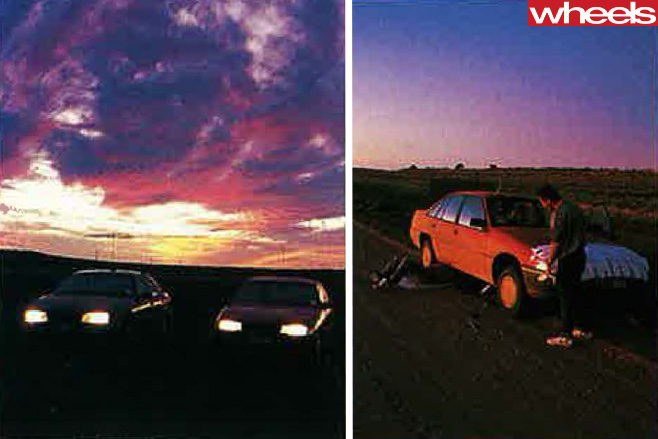
The Falcon sedan’s relative thirst and lack of range brought some concern in the outback. It was the only one we (once) had to top up from our petrol reserves, but on several occasions was pussy- footed to refilling points with the needle below the red sector. On the fairly fast but steady hop from Broken Hill to Balranald the EA auto manual aged almost 500 km with something to spare. No worries. Reckon? The fill took 69.77 litres. Capacity is 68.
ON THE ROAD
This is where things start getting really close because both models drive damn well and handle, steer and brake similarly. The Commodore tends to contradict its interior dimensions by seeming smaller and feeling lighter than the Falcon. It drives that way, too. For example, there’s little to choose between the two for steering weighting and feel. That’s understandable because both are power assisted Bishop type variable ratio rack and pinion systems.
But while the Falcon’s steering is amply direct with 3.25 turns lock to lock, the Commodore’s is even more responsive and suggestive of a smaller car with 2.75 turns. On the other hand, the Falcon has a slightly smaller, slightly quicker wheel of 390 mm, 15 mm less than the Commodore’s. Some of our crew disliked the Holden rim’s thumb rests, but none minded its large size.
Both cars are inherently stable platforms but it’s obvious the Falcon tracks truer than the Commodore on straights. You simply aim the Ford into the distance and it goes where it’s pointed with little if any further attention.
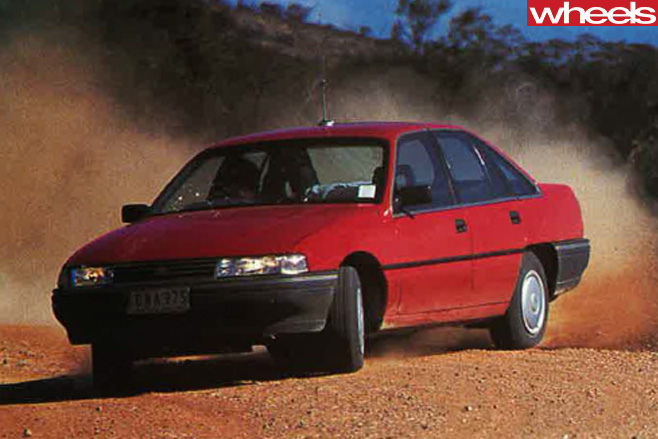
Both models handle very well indeed. They’re confidently sure-footed, extremely well balanced and absolutely predictable in their behaviour. Ordinarily, both are typical mild understeerers with well-developed cornering capabilities. Again the Holden gives an impression of being a touch lighter and more agile in its handing, but the Falcon is in fact no less adroit. As a rule the Falcon turns-in a little better, has less inclination to push its nose wide when driven deep into corners, and doesn’t develop as much body roll. Its rear-end is also better behaved on washboard surfaces and corrugated corners; it’s even less skippy or twitchy than the well-mannered VN which shows much improvement over earlier Commodores in those conditions. But in most handling situations and through most kinds of corners the two rivals are so evenly matched that they tend to be separated only by drivers’ personal preferences.
The cars’ ride qualities are easier to separate. Both ride well, but differently, and one’s better than the other. While the Commodore’s not unnecessarily firm or coarsely harsh, its ride is obviously sharper and more vertical than the Falcon’s. And ultimately somewhat less comfortable because of the jiggly bounciness. The Ford has a better rounded ride. Sometimes verging on flopiness, but without wallowing mushily, the EA soaks up small irregularities as absorbently as large ones.
The suspension is supple yet well controlled even though the standard damping errs towards softness. Experience with S model Falcons has taught us that the EA can use firmer dampers to improve suspension control without detracting from ride quality.
In the absence of chassis torsional-rigidity and beam stiffness figures from the makers, our rough-road test suggests the Falcon’s structure generally is the tougher of the two. The Falcon’s doors didn’t drop like the Holden’s for instance, and the Holden finished the run feeling much looser in the body and suspension, with the odd rattle here and creak there whereas the Ford seemed almost as taut as ever. Though the wheel covers are visual, not structural, our indifference to the Holden covers’ unappealing style was vindicated when they trapped mud and stones against the wheel rim and led to a severe imbalance problem.
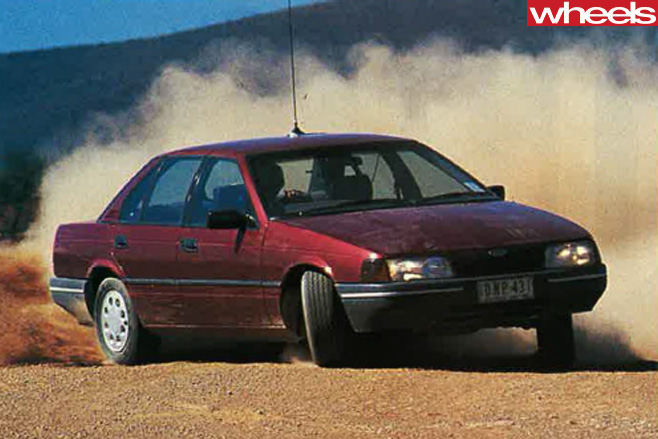
The brakes on both models are big and powerful, another aspect where their performances are virtually equal. Both have pedal action which is reasonably weighted and progressive to be responsive while not unduly sensitive. In spite of the gruelling conditions and the frequent need to pull the cars down from high speed to avoid birds or beasts, the brakes weren’t found wanting. Even when stinking hot from repeated abuse they remained consistent and held our confidence. Only in very trying conditions on the dirt was the Holden slightly more prone than the Ford to lock-up the brakes. But the tendency wasn’t common or critical.
The outback legs also showed that the Holden hasn’t quite as much ground clearance as the Ford; it was always the Executive that scraped first or hardest on high crowns, and in those conditions both had their share of awful sound effects as rocks and gravel peppered the undersides. There were noises noted in normal conditions, too. Holden claims the VN is much quieter than the EA. Difference is certainly noticeable when driving one automatic immediately after the other. In top, the lower geared Falcon sounds much busier than the highly relaxed Commodore. But at cruising speeds there’s little between them for wind noise. Road/tyre noise, too, generally is similar except that the Commodore emits a dreadful drone on some coarse surfaces. It’s interesting too, that when we did our usual noise-meter test at run’s end, both the Holdens gave noisier numbers than the Fords. The bland-sounding exhaust system took a terrible hammering on rough roads, but all were intact, without leaks, and didn’t affect the noise levels.
ACCOMMODATION
The Executive has a good, one-size-suits-all sort of driving position with which an apt relationship between pedals and wheel is complemented by a seat which has generous fore-aft travel and cushion height adjustment.
The Falcon’s driving position drew a mixed reception from our team. Some found it quite acceptable. Others objected to the seat and wheel being askew, not at right angles to the centreline, and the very tall wanted a bit more rearward travel to get farther from the pedals. Most agree the wheel’s height and reach adjustments are a welcome bonus, but would have preferred seat height adjustment.
Quite apart from the height factor, the Executive’s bucket is the better of the two because its cushion is deeper, more supportive and more comfortable. You sit on, not in, the GLs seat because the cushion is too flat, too firm and lacking in thigh support. The Falcon’s problem is compounded by its untenable armrests and lack of grab handles. The Holden has grabs built into its armrests and includes handles above the rear doors. There’s nothing to hold on to In the GL, and that’s a real bitch even for short distances, let alone on long hauls.
The armrests are no comfort either because they’re as hard as nails. Falcon-elbow was the most universal and lingering ache from the trip. (Though the S has better front seats than the GL, and gets overhead assists for the passengers, it suffers the same elbow aggro.)

Ford wins all the points for its fascia, instruments and controls. The Commodore is singularly unimpressive in its plain panel, its bland binnacle, and its dreary dials. But most criticism goes to the wiper and headlight controls, two small barrels have small tabs which suggest finger-tip operation.
Only by accident. Even with familiarity, some of our drivers knocked the lights on when dragging a hand across behind the wheel while exiting. And the wipe control means at least three distinct off-wheel hand movements for every ac:tuation – reach, turn, retract.
Bad one, General. In complete contrast, Ford’s two-stalk system is easy, fast and foolproof. The left-hand wand is simply flicked down for intermittent or regular wiping, pressed up for single sweeps.
Though the GLs instruments are just as basic as the Executive’s, they’re more presentable, by day anyway. At night the Holden’s dials come good to rival the Ford’s for appearance and legibility. The Falcon has better ventilation and heating distribution than the Commodore, and our crew unanimously preferred the Ford’s slides to Holden’s rotary controls.
And so to the rear bench where the Ford makes amends for some of the front seats’ deficiencies. Both makes have more than enough hip, knee and foot room. For the very tall the Falcon’s headroom is marginal and the Commodore’s almost zero. Both rear compartments are, of course, generously roomy for two. Unlike Holden’s tape measure, ours credits the Falcon with slightly more shoulder width. The Falcon has more usable three-seater width because the Commodore’s seat-belt mounts are much too low on the C pillar and grind into the passengers’ shoulders. The Falcon also has the best seat with the more comfortable backrest and deeper, more supportive cushion. But the Commodore has more backrest rake.
LUGGAGE
Measured to industry standards, the Commodore’s boot has 566-litre capacity, against 470 for the Falcon. But the Ford is by no means eclipsed. Though its compartment lacks the Holden’s sheer height, the floor lengths are virtually the same. And because its spare wheel stows flat in a floorwell, instead of upright on the side like the Commodore, the Falcon’s boot has considerably more width behind the arches, rather less between them.
Initially it seemed the Commodore’s boot was exceptionally well sealed because after the first dusty leg the Holden’s luggage was still clean whereas the Falcon’s was lightly powdered. But as we drove on, dust found its way into the Commodore too, albeit less densely than in the Ford which, by the time we hit the bitumen again, was looking a bit like the inside of a vacuum cleaner bag.
CONCLUSIONS
Hey guys, we tried … but the bastards wouldn’t break. We gave ’em heaps, flogged ’em through the dirt, stone-washed their bellies and muscled ’em through the mud. Though bruised here and battered there, they took everything we and the outback threw at them and still got us home with no major hassles. Some things bent, and some (minor) things fell off, and we had a few of the inevitable punctures (tyres and tanks). But nothing broke.
That was perhaps the real result – an impressive demonstration of sheer stamina. Remember, these were two showroom stock family cars, Aussie style family cars that is, not even rigged as they can be for country driving. We can’t think of many other standard models we’d try to drive so far, so fast so hard with such confidence. They really are built for Australia. And they’re good tough cars. But one is better than the other.
Even if the Executive and GL were absolutely level in every other way, we’d have to pick the Commodore just for its front seats, armrests and handles; they’re that decisive in the long run. But of course the Executive and GL aren’t level in other ways. It’s not enough that the Falcon is generally seen as the better looking of the two and has a chassis that is better than Holden’s in some respects and at least equal elsewhere. The General has trumped Ford on price and performance. You can have a manual Falcon that will keep the Commodore honest for acceleration, flexibility, response and perhaps consumption also. But you won’t get it for $20,807 because that only buys the little engine. To be in the hunt you’ll need another $984 for the 3.9 multi-point engine.
The Ford has an even bigger handicap as an automatic because apart from costing almost a grand more to get on equal engine terms, it doesn’t have an answer to Holden’s four-speed at any price.
Make no mistake, there are things about the EA Falcon to commend it, and it may well be fully competitive at manual Fairmont or Fairmont Ghia level where the multi-point engine is standard. But in the big selling base level the VN looks like being the right car. From where we sat during this giant comparison test it’s clear that Ford has been caught with prices up and performance down. That’s not what winners are made of.



